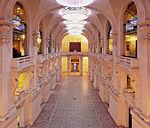Arc de Triomphe du Carrousel
Buildings and structures completed in 1808Buildings and structures in the 1st arrondissement of ParisMonuments and memorials in ParisTriumphal arches in France

The Arc de Triomphe du Carrousel (pronounced [aʁk də tʁijɔ̃f dy kaʁusɛl]) (English: Triumphal Arch of the Carousel) is a triumphal arch in Paris, located in the Place du Carrousel. It is an example of Neoclassical architecture in the Corinthian order. It was built between 1806 and 1808 to commemorate Napoleon's military victories in the Wars of the Third and Fourth Coalitions. The Arc de Triomphe de l'Étoile, at the far end of the Champs Élysées, was designed in the same year; it is about twice the size and was not completed until 1836.
Excerpt from the Wikipedia article Arc de Triomphe du Carrousel (License: CC BY-SA 3.0, Authors, Images).Arc de Triomphe du Carrousel
Jardin du Carrousel, Paris 1st Arrondissement (Paris)
Geographical coordinates (GPS) Address External links Nearby Places Show on map
Geographical coordinates (GPS)
| Latitude | Longitude |
|---|---|
| N 48.86173 ° | E 2.33291 ° |
Address
Arc de Triomphe du Carrousel
Jardin du Carrousel
75001 Paris, 1st Arrondissement (Paris)
Ile-de-France, France
Open on Google Maps








